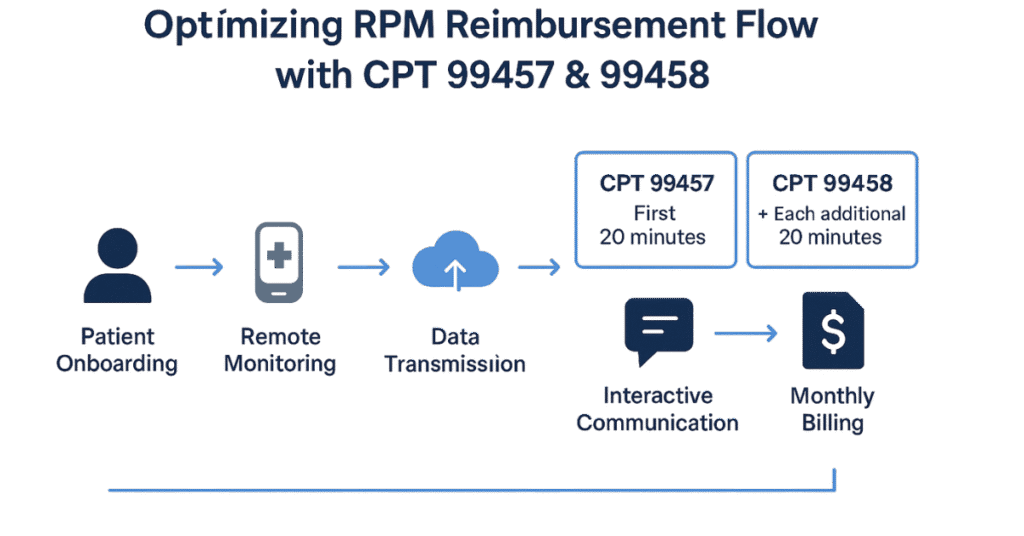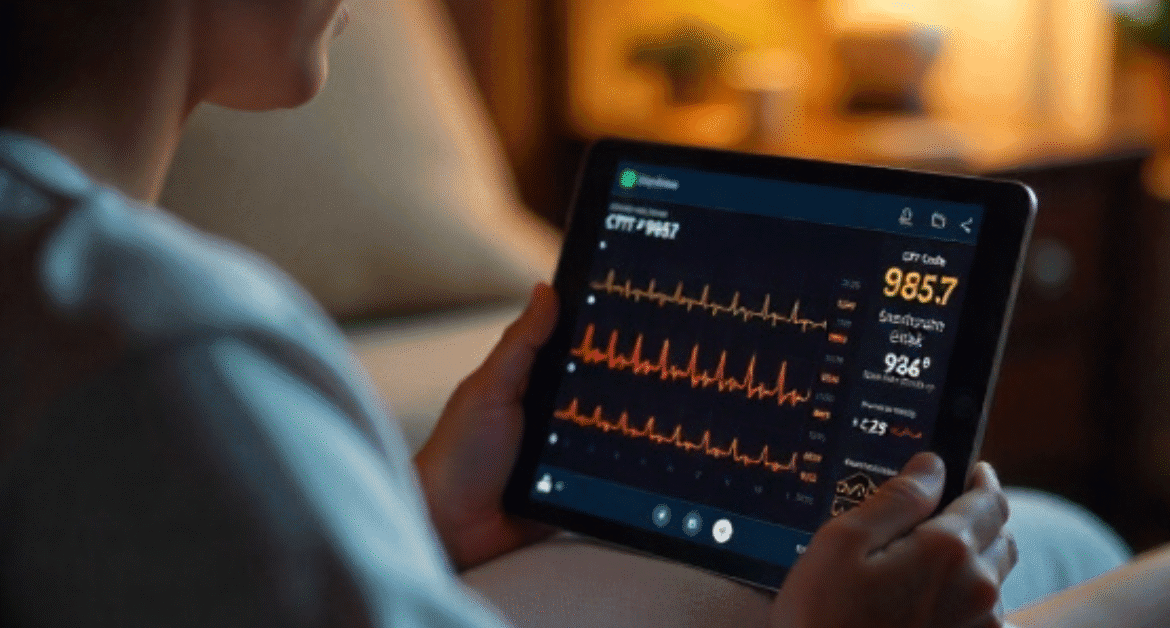CPT Code 99457: Navigating Remote Patient Monitoring & AI Integration for Enhanced Patient Care and Revenue Cycle
Remote Patient Monitoring (RPM) has, in fact, become really indispensable for delivering value-based care. Physicians, specialty practices, and clinics are actually leveraging RPM to extend care way beyond traditional settings. This approach not only improves patient outcomes but also, as such, enhances operational efficiency. Artificial intelligence (AI) further optimizes these clinical workflows, particularly in managing revenue cycles. Understanding key billing codes, like CPT code 99457, is, to be fair, crucial for unlocking the full potential of these benefits. This post will detail RPM integration, CMS billing, and the real practice-level advantages these technologies offer today.
Understanding CPT Code 99457: The Core of RPM Reimbursement
Navigating the complexities of remote patient monitoring reimbursement begins with a clear understanding of CPT code 99457. This code is, in fact, foundational for practices aiming to integrate virtual care effectively. It directly impacts revenue capture and, as such, the sustainability of RPM programs. It’s a pretty important one, for sure.
What is CPT Code 99457?
CPT code 99457 describes Remote Physiologic Monitoring treatment management services. It specifically covers at least 20 minutes of clinical staff, physician, or other qualified healthcare professional (QHCP) time during a calendar month for interactive communication and treatment management. This time involves the review of physiologic data transmitted from RPM devices. To be fair, it also encompasses therapeutic data from Remote Therapeutic Monitoring (RTM) services. It’s truly a comprehensive code for what it covers.
Key Requirements for Billing 99457
Billing CPT code 99457 requires strict adherence to specific guidelines to ensure reimbursement. The most critical is, actually, the 20-minute minimum time threshold. This time must include interactive communication. Such communication involves live phone calls or video conferences, not just texts or emails. Physicians, advanced practice registered nurses (APRNs), or clinical staff under general supervision can bill for this service. Meticulous documentation is paramount. Practices must maintain detailed time logs, records of clinical discussions, and evidence from data review. You really can’t skip on the documentation, it’s that important.
Compliance Requirements for RPM/CCM Billing
| Requirement | Description | Compliance Tip |
|---|---|---|
| Minimum Time (20 min) | At least 20 minutes of clinical staff/physician/QHCP time per month. | Track all time accurately, including data review and communication. |
| Interactive Communication | Must include live phone or video interaction with the patient. | Document date, time, and content of all interactive communications. |
| Eligible Professionals | Physicians, APRNs, PAs, or clinical staff under general supervision. | Verify staff qualifications and supervision levels for billing. |
| Documentation Detail | Time logs, clinical discussions, data review, and patient consent. | Use an integrated system to capture all required documentation. |
Demystifying 99457 CPT Code Reimbursement & Billing
Optimizing revenue from Remote Patient Monitoring hinges upon a precise understanding of CPT code 99457 reimbursement and its associated billing guidelines. Practices must, in fact, meticulously manage these aspects for ensuring financial viability and avoiding denials. It’s a complex area, for sure.
Navigating Reimbursement for CPT Code 99457
Reimbursement for CPT code 99457 varies based upon factors like geographic locality and specific payer contracts. For Medicare, the national average reimbursement is subject to annual updates by the Centers for Medicare & Medicaid Services (CMS). Practices should, as such, consult the most current Medicare Physician Fee Schedule (MPFS) for precise rates. This code is billable once in a calendar month per patient. Understanding these nuances actually helps practices project revenue accurately and manage expectations. It’s all about staying current with the guidelines.
CPT Codes 99457 and 99458: Understanding the Synergy
CPT code 99458 serves as an add-on code to CPT 99457. It allows for billing additional 20-minute increments of clinical staff/physician/QHCP time beyond the initial 20 minutes covered by 99457. Practices can, in fact, bill 99458 up to two times per calendar month per patient, alongside 99457. This is particularly relevant within complex cases where extensive monitoring and interactive communication are clinically necessary. Justifying the additional time with clear documentation of increased patient needs is, to be fair, crucial. It’s a nice way to get paid for extra time.
Essential 99457 CPT Code Billing Guidelines for Practices
Adhering to essential 99457 CPT code billing guidelines is critical for preventing claim denials. Practices cannot count time already billed for other services, such as Evaluation and Management (E&M) or Chronic Care Management (CCM), towards the 99457 minimum. Patient consent for RPM services is mandatory and must be documented. Ensuring accurate tracking of interactive communication and overall time spent is, actually, vital. Practices must also confirm patient eligibility and device data transmission regularity for meeting CMS requirements for related RPM codes. Following these rules really helps avoid headaches.

Operationalizing RPM with AI: Clinical & Efficiency Gains
Integrating Artificial Intelligence (AI) into Remote Patient Monitoring (RPM) programs significantly enhances clinical outcomes and streamlines practice operations. AI, as such, transforms raw data into actionable insights, improving patient care and staff efficiency. It’s a big step forward.
Clinical Decision-Making Enhanced by AI in RPM
AI algorithms actually analyze vast datasets from RPM devices to identify subtle trends, detect anomalies, and predict potential health deterioration. This proactive approach supports earlier intervention, preventing adverse events. For instance, AI can, in fact, identify patterns indicating worsening cardiovascular conditions or respiratory issues, prompting timely clinical action. It also facilitates personalized treatment plan adjustments by correlating physiological data with patient responses. AI-driven risk stratification allows clinicians to prioritize care for high-risk patients, optimizing resource allocation. This really changes how we approach patient management.
Impact of AI-Powered RPM on Patient Outcomes
Streamlining Practice Workflows with AI-Driven RPM Solutions
Manual review of extensive RPM data can, to be fair, overwhelm clinical staff. AI-driven solutions automate data analysis, flagging only critical alerts that require immediate attention. This reduces data overload and frees up staff time for direct patient interaction. AI prioritizes patient outreach based on urgency, ensuring timely communication. Seamless integration with Electronic Health Records (EHRs) allows for automatic data flow, reducing manual entry errors and improving documentation accuracy. SmartCare360 offers robust EHR integration solutions to enhance these workflows. It’s about working smarter, not harder.
Physician Usability: Intuitive Platforms for Better Care
Effective RPM platforms must, in fact, offer intuitive interfaces that minimize administrative burden for physicians and clinical staff. User-friendly dashboards provide quick, customized overviews of patient data, highlighting key clinical insights. Automated reporting features reduce time spent upon documentation, allowing more focus on patient care. Such platforms simplify the process of reviewing physiological data, managing patient communication, and documenting interventions. This actually improves physician satisfaction and overall care delivery. A good platform really makes all the difference.
Addressing Revenue Cycle Management with SmartCare360
Effective revenue cycle management (RCM) is paramount for the financial success of Remote Patient Monitoring programs. SmartCare360 supports practices in optimizing every stage of their RPM RCM, from patient intake to claim resolution. It’s a crucial part of the whole picture.
Beyond Billing: Proactive Revenue Cycle Management for RPM
True revenue cycle management extends beyond mere claim submission. For RPM, this means optimizing patient intake processes, including thorough eligibility verification and obtaining explicit patient consent for services. Accurate coding is, as such, crucial, encompassing not only CPT 99457 but also related codes like CPT 99453 for initial device setup and education, and 99454 for device supply and data transmission. Proactive RCM ensures that all services are appropriately documented and coded from the outset, minimizing future denials. SmartCare360 Revenue Cycle Management Services provide comprehensive support in these areas. It’s about being proactive, not reactive.
Preventing Denials and Maximizing Collections
Common reasons for RPM claim denials include insufficient documentation, lack of documented interactive communication, and failure of meeting the 16-day data transmission rule for CPT 99454. Practices must, to be fair, implement robust auditing processes for identifying potential errors before claim submission. Developing a streamlined appeals process for denied claims is also essential for maximizing collections. AI can, in fact, play a significant role here, identifying potential billing errors or compliance gaps in real-time, greatly reducing the incidence from denials. It’s a game changer for the billing department.
Monitoring Key Performance Indicators (KPIs) for RPM Success
Successful RPM programs rely on continuous monitoring of key performance indicators (KPIs). Relevant metrics include patient engagement rates, adherence towards monitoring schedules, and device utilization. On the financial side, tracking claim denial rates, average reimbursement per patient, and staff time spent per patient provides, actually, critical insights. Data analytics, facilitated by platforms like SmartCare360, enables practices to identify areas for improvement in both clinical outcomes and financial performance, ensuring sustainable growth. Keeping an eye on these numbers is vital.
Conclusion:
Understanding CPT code 99457 is, in fact, fundamental towards establishing and sustaining a successful RPM program. Integrating AI into RPM workflows significantly enhances both clinical efficiency and revenue cycle management. By leveraging advanced tools and strategic approaches, practices can deliver superior patient care while ensuring financial viability. Explore SmartCare360.health’s solutions for seamless RPM and RCM integration.
FAQ's
What specific documentation is required for CPT 99457?
Documenting CPT 99457 requires a detailed log of the 20 minutes of qualifying time. This includes dates, times, and content of interactive communications. Records of data review and clinical decision-making based on RPM data are also necessary. Patient consent for RPM services must, as such, be on file.
Can a nurse practitioner (NP) bill for CPT code 99457?
Yes, a nurse practitioner (NP) can, in fact, bill for CPT code 99457. This code allows for billing by physicians or other qualified healthcare professionals (QHCPs). Clinical staff, including NPs, can perform the service under general supervision.
How does AI assist with 99457 compliance?
AI assists with 99457 compliance by automating time tracking and identifying incomplete documentation. It can, actually, flag instances where interactive communication requirements are not met. AI also helps ensure adherence to data transmission rules, minimizing billing errors.
Is CPT 99457 billable for all patient types?
CPT 99457 is primarily for Medicare beneficiaries, but private payers may also cover it. Practices must, to be fair, verify specific payer policies and patient eligibility. The patient must have a chronic condition requiring remote physiologic monitoring.
What distinguishes CPT 99457 from other RPM codes?
CPT 99457 covers the monthly treatment management and interactive communication component of RPM services. It differs against codes like 99453 (initial setup) and 99454 (device supply/data transmission). These codes actually represent distinct, separate aspects of RPM.












